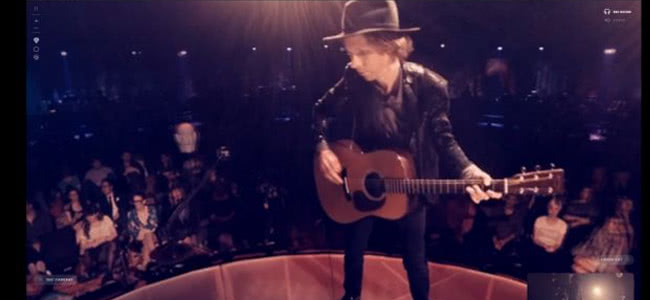If you think Beck couldn’t be pegged as any more eccentric, well think again.
After the seemingly spontaneous return of David Bowie this year with a new single “Where Are We Now?” from his first album in a decade, The Next Day, renewed interest in the glam rock star has manifested in the sensory-saturated brainchild project of Beck and director Chris Milk.
Beck was enlisted to do a run-down of David Bowie’s 1977 hit “Sound and Vision” for under the “Hello, Again?” ad campaign for Lincoln Motors, which sees “artists reinterpret familiar material,” as reported by Pitchfork earlier this month.
It could be said of Beck and Milk’s approach that it was a literal re-interpretation, where an emphasis on both senses, sound and vision, has resulted in an extravagant 167-piece orchestral performance of the Bowie classic.
As well as a futuristic technological take on the performance with the utilisation of 360 cameras, facial tracking, and so-called “multi axis binaural sound heads,” as Chris Milk tells Gizmodo, for great auditory effect. All of this possible right from the well-worked-in grooves of your chair at home.
Milk’s experimentation with multi-sensory online performance technology can be interpreted as the ushering in of new era: where a manipulation of stage settings and aforementioned interactive technology can produce a ‘somewhat-artificial-yet-kind-of-real’ experience which according to Milk is better than the real deal from the ‘moshpit’. In short, it’s the closest to being on stage a fan can get.
“The viewer or listener or user isn’t a passive receiver anymore: they’re participating in the narrative, they’re co-creating the art.” – Chris Milk, DirectorHaving a choice of three camera angles (a view of the audience, Beck, and the orchestra) as well as all the other interactive-technological perks implied, to watch such an epic nine minute performance, has sparked great enthusiasm and debate online.
In an interview with Gizmodo, director Chris Milk discussed the fine balance between both an indulgence in creativity and the temptation to use technology for merely technology’s sake. Where a switch in dynamic is made, according to Milk, and “the viewer or listener or user isn’t a passive receiver anymore: they’re participating in the narrative, they’re co-creating the art.”
Despite a sense of autonomy given to audiences via interactive technology, Milk does acknowledge the underlying artifice of such an experience, emphasising: “Let’s be clear though, no matter how much control you give an audience, you are always presenting some sort of curated experience.”
Milk believes such a fundamental deficiency can be somewhat compensated with the time and effort put in by designers or so-called “curators”, where hard work results in rewards for both the receiver and the sender of the experience, as is the case with Beck’s grand “Sound And Vision” cover.
Whether you’re on one side of the debate or not, it’s the innovation and pushing of boundaries and moving of frontiers which is undeniably remarkable about the technology being showcased by Milk, and delivered by Beck. Where access into another person’s space and perspective cannot be rivalled by any other medium.
Milk’s high ambitions still managing to come across as humble:
The thing that’s always struck me is how different the sensory, especially auditory, experience is when you’re in the middle of the music with the musicians playing off each other around you, versus when you’re in the audience and have a wall of amplified sound coming at you from one direction… I wanted to recreate that perspective on a large scale so hundreds of people in a room, and eventually many more online, could be immersed in a phonic environment that they’d never normally have access to.”
Imagine, Ziggy Stardust in surround sound – it couldn’t get any better that that, could it?
You can view Beck’s epic Bowie cover, and Chris Milk’s interactive video here.

































